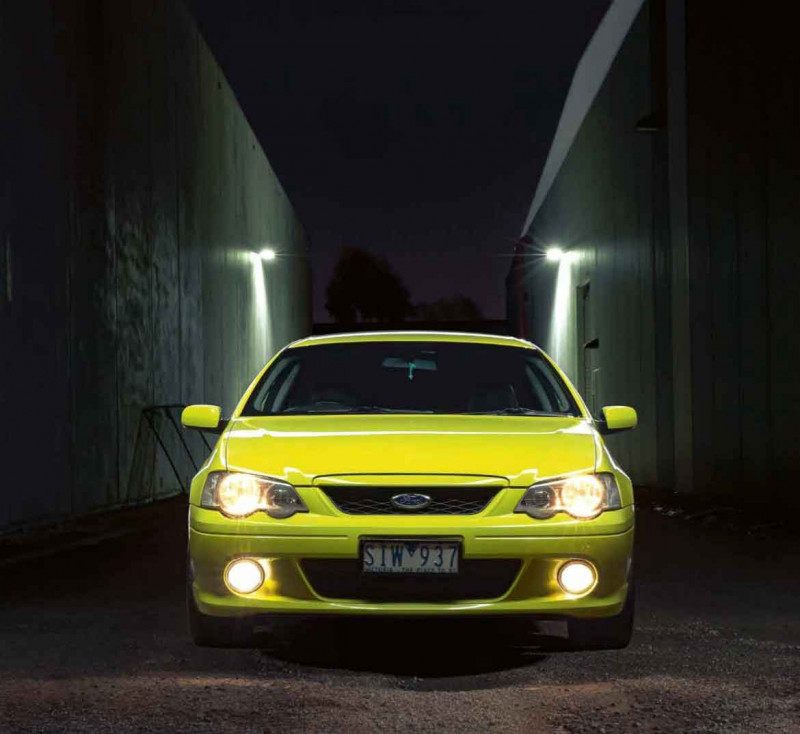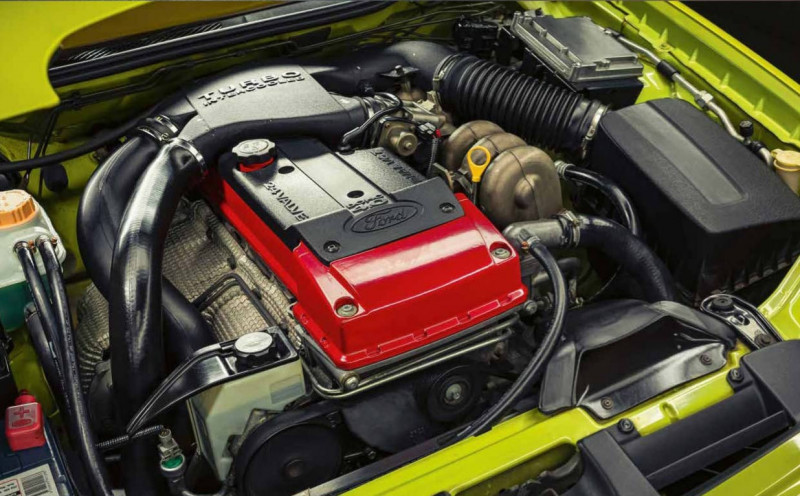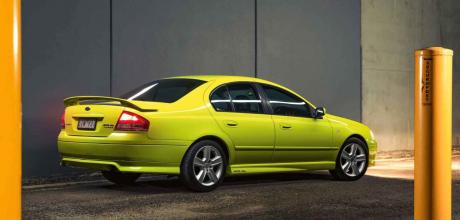2002-2004 Ford BA Falcon XR6 Turbo
Ford Falcon adding a turbocharger to ford’s BA Falcon sports sedan elevated it to Aussie-Icon status. Photos Alastair Brook.
MODERN CLASSIC Adding a snail to the BA XR6 turned this sports sedan into an Oz muscle classic
Until the BA Falcon XR6 Turbo of 2002, Ford Australia had never really produced a decent six-cylinder engine. Torquey, strong, and as simple to maintain as a modest alcohol dependency, but for such a long time about as inspiring as devon and sauce.

Even at its best, either without pollution gear (as in the ’71 XY Falcon 250 2V) or with an alloy head and sophisticated fuel injection (as in the ’83-87 XE/XF 4.1 EFI), Ford’s long-stroke, pushrod straight six was a hoary old thing famous for its fan noise and 40-a-day wheeze. And later overhead-camshaft developments weren’t much better. The last pre-BA ‘performance’ Falcon six – the AU XR6 VCT (for Variable Camshaft Timing) – was so harsh and vibey when pushed hard that it threatened to hacksaw its way through the firewall. No wonder buyers favoured the increasingly powerful (if similarly ancient) Windsor V8, though let’s be honest – no-one really favoured the 1998 AU, not even Ford insiders. Without this now-legendary miss-step, however, the 2002 BA would never have been such a comprehensive makeover. And without this commitment to making the BA Falcon such a cracking model range – the first Falcon since 1966 to win Wheels Car of the Year – the XR6 Turbo may never have seen the light of day, certainly not in the form you see here.

It made an indelible mark on the new-millennium Australian performance-car landscape, yet the turbo version came about simply to give the XR6 badge some performance presence, in no small part because the completely re-engineered twin-cam, 24-valve 4.0-litre ‘Barra’ six that powered the vast majority of BA Falcons was such a superb piece of work. “We wanted to give the XR6 a bit of a kick-along because we felt it was a bit lacking in personality compared to the XR8,” said Gordon Barfield, the now-retired Special Vehicle Operations manager for Ford Australia and the man credited with coming up with this turbocharged Falcon concept. “We felt that this six-cylinder [model] needed to be able to really make a name for itself. We were worried the XR6 was probably a little bit underwhelming, so we wanted to give it some spirit.”
It’s no longer a secret that Ford considered supercharging the 4.0-litre – providing a hardly coincidental connection with the supercharged Jaguars of the period (the British marque was still part of the broader Ford family). At concept stage, Barfield and revered product planning manager for Tickford Vehicle Engineering, Howard Marsden, were the only two people working on the program, and Marsden favoured supercharging.
“Howard was really, really, pushing for a supercharged engine. He really wanted the grunt of a supercharger and I agreed with him,” said Barfield. “But having established an architecture around the six-cylinder engine, it was really difficult to think about a frontend drive with another pulley for the supercharger … and that’s why I made the suggestion that we go turbo.”
Tickford in the UK had investigated working over the almost-completed, naturally aspirated 4.0-litre ‘Barra’ but everyone felt that an additional handful of kilowatts wasn’t worth the effort. “We needed to have something that was not brutal but needed to be a significant upgrade from what would be the cooking engine,” says Barfield.
The brief was at least 20 percent more power – something that was clearly noticeable on the road – but the turbocharged engine also needed to be easily slotted into the huge BA program without signifi cantly impacting on the engineering of the rest of the car. “We found that we could package the Garrett [GT40 water-cooled ball-bearing] turbo okay; we felt that the intake manifold was okay; but the throttle body would have been too restrictive, so that went up in size, and the major installation part was the intercooler, because we insisted that [the engine] was intercooled,” reflects Barfield now.
What was conceived was a low-pressure turbo installation building on the already-excellent torque characteristics of Ford’s large-capacity, long-stroke six, rather than something explosive. Running just 0.4bar of boost (6psi) and fed by an air-to-air intercooler, the Garrett turbo was instrumental in boosting the 4.0-litre’s power output by 32 percent (to 240kW at 5250rpm) and torque by 18 percent (to 450Nm from 2000-4500rpm).
To digest its preferred 95-octane diet, the compression ratio was lowered from 9.7:1 to 8.7, and the boosted engine also featured Inconel exhaust valves, a stainless-steel exhaust manifold, dished pistons, higher fuel pressure and altered timing for the dual variable camshafts.
While the $500 million worth of changes between the BA Falcon and its AU predecessor were immense – 80 percent of components were changed and only the door skins were carried over, with even the front seating positions and gearshift placement altered – the differences between the every-person’s BA XR6 and the boosted XR6 Turbo weren’t huge … apart from the engine.
Only deliberate inspection would reveal the Turbo’s front-mounted intercooler and ‘Turbo’ bootlid badge, not to mention its limited-slip differential and recalibrated traction control. While the BA’s standard 298mm ventilated front discs (with 40-percent-stiffer twin-piston aluminium floating calipers) and 303mm solid rear discs were a vast improvement over the AU’s stoppers, the XR6 Turbo also offered an optional (and preferable) ‘Premium Braking Package’ with 325mm ventilated PBR front discs, as well as 18-inch alloys.
Inside, changes were even more minute. While all BA XR models featured unique sports seats and XR-branded instruments with blue back lighting (copying standard-setting Volkswagens of the era), the Turbo added rear power windows and rear grab handles over the base XR6.
On the road, however, the differences between the two were blatantly obvious. The stock 182kW/380Nm 4.0-litre was already a stout engine, but the 240kW/450Nm turbocharged version was in a league of its own. Tractable from just 1200rpm, once the 240T (as Ford called it) climbed onto its vast torque shelf at two grand, it offered a smooth, unrelenting surge of acceleration right to the 6000rpm cut-out, backed by the character of an urgent exhaust woofle.
The XR6 Turbo may not have delivered the whack-in-the-back turbo kick of an Impreza WRX – the zeitgeist performance car of the late-’90s – but its refined chubbiness was perfectly in keeping with its five-seater-flyer status. Combined with a firm yet supple ride, a sweetly balanced chassis, crisp, accurate steering and a suave dynamic personality, family types with an enthusiast bent (or anyone who cherished a big, rapid, affordable rear-drive sedan) never had it so good.
At the dragstrip, the XR6 Turbo revealed superlative acceleration – six-dead to 100km/h and low-14s for the standing 400m were top stuff for a production Aussie sedan in 2002. The carry-over BTR electronic four-speed auto was the transmission pick – complete with new tip-shift mode configured the BMW way (downshift forward, upshift back – an 11th hour decision) and a concurrent ‘Sport’ mode when you flicked the lever left.
The manual, on the other hand, was borderline. If the BA XR6 Turbo had a serious weakness, it was the old Borg-Warner/BTR T5 five-speed manual, which struggled to handle the engine’s torque. “It was marginal,” says Barfield, “and that was a bit of a concern for us because here we were winding the engine up and the gearbox probably didn’t have the [torque capacity] headroom that we would’ve liked.”
With gritty shift action, a heavy, feel-free clutch, and plenty of driveline snatch, it paled in comparison to the slick auto. That all changed in October 2004 when the BA MkII (see sidebar, above) arrived, ditching the T5 for a superior Tremec T56 six-speed ’box. The auto then took its step-change with the BF Falcon a year later, gaining the German-made ZF six-speed featured in big-dollar European limos.
The lasting impression of the BA XR6 Turbo is what a superb all-rounder it is. None of its contemporaries could match its blend of comfort and control, and the FG and FGX Falcons that followed it seemed to lack the holistic design – especially in the cabin – that made the BA (and closely related BF) such a cushy brawler.
It was also responsible for helping boost the XR model mix from less than seven percent of total Falcon sales with AU in 2002 to almost 30 percent by 2004.
Yet the true legacy of the original XR6 Turbo is its engine. Did Barfield and has associates know that, almost 20 years later, the 4.0-litre turbo would have the muscle to be able to do the things that it’s managed to do, even in the final XR6 Sprint version with 370kW on overboost?
“We knew it would get wound up,” says Barfield. “All we did was to make sure that the durability of the engine, with the performance levels that we wanted, was capable. It was just a matter of how far could you go before the whole thing disintegrated! But I was really pleased to see that it has a lot more headroom.”
Interior changes between atmo XR6 and XR6 Turbo were minimal – electric rear windows for Turbo
FAST FACTS
SIX OF THE BEST
BA MkII’s Mexican-built Tremec ’box was also shared with Holden’s VZ SS, as well as Corvette, Viper, Mustang Cobra, Cadillac CTS-V and Aston DB7/Vanquish. Key features of Falcon’s T56 included double-cone synchromesh, synchro on reverse and low-friction bearings. XR6 Turbo had a slightly taller first than XR8 (despite a 3.73:1 final drive versus 3.46) but was shorter in all other gears. We clocked an 80-120km/h time of 3.8sec in third for MkII Turbo against 4.5sec for XR8.
Model 2002-2004 Ford BA Falcon XR6 Turbo
- Engine 3984cc 6cyl, dohc, 24v, turbo
- Max power 240kW @ 5250rpm
- Max torque 450Nm @ 2000-4500rpm
- Transmission 5-speed manual or 4-speed auto
- Weight 1710kg (manual)
- 0-62mph (0-100km/h) 6.0sec (tested – manual)
- Economy 12.5L/100km
- Price (now) $14,000-$20,000
GIVEN A BOOST
MAKING ITS MARK
Mid-life ‘MkII’ update for BA centred around a new Tremec T56 six-speed manual gearbox for XR6 Turbo and XR8, but also included range-wide enhancements. For XR6 Turbo, that meant chunkier 17-inch alloys, a centre-rear armrest, illuminated power window switches, auto-on headlamps and four new colours – Blaze red, Rapid yellow, Velocity blue and Shockwave blue. XR8 uniquely scored 18s, tweaked suspension and a premium audio system.
The BA XR6 Turbo delivered a firm yet supple ride, sweetly balanced chassis, and crisp, accurate steering
DATA SET
- 25% PERCENTAGE OF MANUAL BA XR6Ts, VERSUS 40% FOR XR8
- 73,220 BA’S BEST SALES YEAR – 2003
- 504 LITRES OF BOOT CAPACITY IN BA FALCON SEDAN
- 700 KG REDUCTION IN BRAKED TOWING CAPACITY FROM 2300KG OF BA XT AUTO TO XR6 TURBO AUTO
- 12 DISTANCE IN MM THAT EACH BA FRONT SEAT WAS MOVED TOWARDS THE CENTRELINE COMPARED TO AU
- THE GOOD + Wonderfully smooth and torquey engine; suave dynamics; cabin space and comfort; handsome shape; Aussie design cred; parts support
- THE BAD — Gritty shift quality and heavy clutch of five-speed manual; carry-over AU doors a bit clunky; thirsty when driven hard; premium brakes optional; stability control; many have been modified
Packaging the intercooler would prove to be the most challenging part of the BA’s turbo installation
The stock 182kW/380Nm 4.0-litre was already a stout engine, but the 240kW/450Nm turbocharged version was in a league of its own


